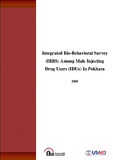Please use this identifier to cite or link to this item:
https://hdl.handle.net/20.500.14356/654| Title: | Integrated Bio-Behavioral Survey(IBBS) Among Male Injecting Drug Users (IDUs) In Pokhara 2005 |
| Authors: | Family Health International NEW ERA SACTS |
| Issue Date: | 2005 |
| Keywords: | Integrated Bio-Behavioral Survey(IBBS) Male Injecting Drug Users (IDUs) Pokhara Valley |
| Abstract: | EXECUTIVE SUMMARY HIV transmission among drug users is associated with injecting drug use that involves the sharing of needles or syringes. Risky sexual behavior associated with drug use also contributes to the spread of HIV. Injecting drug users function as a “bridging population” for HIV transmission between a core HIV risk group, other high-risk groups and the general population. The main objective of this study was “to estimate the prevalence rate of HIV among injecting drug users (IDUs) and assess their risky behavior". The study was conducted in the Pokhara Valley. Three hundred male IDUs were sampled using the respondent driven sampling (RDS) methodology. While structured questionnaires were used to collect behavioral data, clinical blood tests were used to determine the rate of HIV infection. The clinical test procedure used involved collecting blood from a subject’s pricked finger and then storing it in 2-4 capillary tubes until tests could be performed. In order to determine a participant's infection status, a rapid test kit algorithm was used in which two rapid tests (Capillus and Determine) were initially conducted with Uni-Gold reserved as a tie-breaker. In terms of socio-demographic characteristics, the study found that the median age of the IDUs was 23 years. This is almost similar to the findings of the first round of the survey. A majority of the IDUs had never been married. For the 34% of the IDUs who were ever married, the median age at marriage was 20 years. A majority of the IDUs had formal schooling. IDUs from different ethnic backgrounds participated in the study. The study reveals a trend similar to the one found during the first round of the survey. The IDUs had been injecting drugs for 4.8 years on average. It was found that more than two-thirds of the study participants started using injecting drugs when they were 20 years old or earlier. A majority of the IDUs (28.7%) were found to be injecting drugs two-three times a day. Tidigesic was the most popular drug among the IDUs participating in the first round of the survey but combination of drugs was popular in 2005. Around 61% of the IDUs reported that they had not shared needles/syringes during the past week. However, about one-fifth of the IDUs said they shared needles/syringes usually among two or more friends. Nearly 52% of the IDUs reported having injected drugs elsewhere in Nepal or in another country. |
| URI: | http://103.69.126.140:8080/handle/20.500.14356/654 |
| Appears in Collections: | Post Graduate Grant (PG) Reports |
Files in This Item:
| File | Description | Size | Format | |
|---|---|---|---|---|
| IBBS_IDUs_Pokhara Final Report-2005.pdf | Full Report. Download | 470.59 kB | Adobe PDF |  View/Open |
Items in DSpace are protected by copyright, with all rights reserved, unless otherwise indicated.
